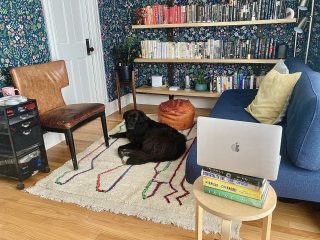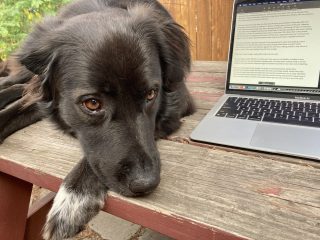
What I’m working on:
I work as a journalist at STAT, where I write about the discoveries that are transforming biology and how those technologies bleed out into wider society—often in unexpected and inequitable ways. I’ve just finished a feature on how the new class of weight-loss drugs are upending our understanding of cravings—not just of foods, but of all sorts of addictive substances and behaviors. I’m relieved to have it out, because I’ve been working on it for more than six months at this point, but also anxious because it’s such a hot topic around which the science is still emerging. I want to accurately capture both the excitement and the uncertainty that researchers are feeling in this moment, which is always a tricky balance.
At the same time, I’m working on a profile of a scientist who is pushing gene editing in a fascinating new direction, and setting up interviews for a story about reproductive trade-offs for patients seeking the CRISPR-based sickle cell treatment that is expected to be approved later this year. And I’m spending a lot of time thinking about what’s happening in the fields of stembryo development—making more-and-more-lifelike models of embryos from stem cells—and in vitro gametogenesis, which is the production of sperm and eggs in a lab. Both have the potential to open up radically new reproductive possibilities for us as a species, but come loaded with ethical minefields. In addition to covering the scientific advances themselves, a goal I recently set for myself is to devote more reporting resources into digging into the social, moral, financial, and geopolitical forces shaping how these provocative fields are progressing. I also curate STAT‘s CRISPR Trackr, which is a tool for keeping up with experiments in genome editing that are pushing these powerful DNA-modifying technologies closer and closer to being a standard part of medical practice.
Where I work:
Most of the year, I work from my home in Minneapolis. My partner and I moved here last summer, so my office is still unfinished; right now it’s mostly a comfy chair, a couch, and a stool stacked with books for optimal Zoom angles. The important thing is it has a door, which was notably lacking from the 650-square-foot apartment we had lived and worked in together for the duration of the pandemic. He teaches at the University of Montana, so during the fall semester we live in Missoula and I work from a home we rent there. In both spots, I try to work outside whenever it’s nice out, taking in either the shade of our hulking purple smokebush or listening to the cottonwoods quivering in the breeze along the banks of the Clark Fork River.

Daily routine:
Unless I’m getting up early for an interview with someone in a different time zone, I usually wake up between 7:00 and 8:00 a.m. when Azalea, our three-year-old border collie mix, hops in bed to let us know she’s ready for her morning exercise. My partner will take her for a walk or run while I make coffee and listen to NPR’s Up First podcast. Over my first cup I spend about 30 minutes skimming headlines from my beat (Science, Nature, MIT Tech Review, etc.) reading emails, looking at my calendar, and chatting with my editor and other colleagues on Slack about any new stories I need to hop on. Then I’ll switch to The Daily, which I’ll listen to while I make breakfast. When my partner gets back, we’ll eat and do the NYT crossword together before heading off to our respective home offices between 9:00 and 9:30. Most days I try to start by sitting down and making a to-do list (which mostly entails copying over the many undone items from the day before), and then I’ll spend the next few hours working through it. Depending on the day, it’s usually a mix of Zoom meetings, interviews, turning around copy on short-turn stories, and researching, writing, and fact-checking longer-form projects in various states of progress. I tend to be working on between two and four stories at any given time.
I don’t really eat lunch, but I try to take a 30-minute break in the middle of the day to lift weights or do some yoga and have a snack.
On writing and research-heavy days, I will often leave the house in the afternoon and bike to a local coffee shop or a campus library. I find the fresh air, a bit of exercise, and a new location to be re-energizing. To further enhance the prospect of doing focused work, I sometimes gamify things by leaving my computer charger at home and giving myself a specific task that I have to accomplish before the battery runs out.
Around 4:30 or 5:00, I take Azalea out for her afternoon activity. In the spring and summer, that’s usually a walk around the neighborhood or to the dog park. In the fall and winter, we’ll head out for a trail run or cross-country ski. After dinner, I usually squeeze in another hour or two of catching up on emails and setting up interviews for upcoming stories, before really logging off for the day. A few times a month, if I’m behind on a deadline, I’ll stay up late to write. But most of the time, by 8:00 or 9:00 I’m ready to turn my brain off and read, watch a show, play some cribbage, or meet up with friends. I give myself a break from post-dinner work in the summer, because the evenings quickly fill up with Ultimate Frisbee practice, pickleball league, and long bike rides.

Most productive part of my day:
I do my best writing late at night. There’s something about the dark and quiet of the hours between 10:00 p.m. and 3:00 a.m. that allows me to think creatively and put words to paper like no other time. I’ll put on my headphones and know that no one is going to be pinging me, no dog is going to be wanting a walk, there’s nothing fun going on with my friends I’m missing out on, and things just start clicking. Because it’s pretty disruptive to my regular routine, I try not to make a frequent habit out of it, but when I’m feeling the pressure of a deadline and things just aren’t coming together, I’ll let my inner night owl out for a prowl.
Most essential ritual or habit:
Making time for a real dinner away from any screens. My partner and I really love to cook, especially now that we have a garden, so most nights we’ll put on some music, pour a cocktail, and catch up while preparing the meal, which we’ll eat by candlelight. Once or twice a week we’ll go out to try a new restaurant or revisit a favorite spot. Even during times of heavy workloads, carving out that space to connect and be creative in a totally different way is vital for my mental health.
Favorite note-taking techniques/tools:
Midori MD Notebook, Pilot Juice-Up 4 retractable gel pen, Bose Noise-Canceling Headphones 700, TextEdit.
How I keep track of my to-do list:
I have a paper notebook where I write a to-do list each day. On one side I’ll list tasks to check off, on the other I’ll block out times in the day to work on the biggest-lift items. I also keep a shared Google Doc with my editor, where I update him with progress on stories and keep a running list of future reporting targets. That helps us prioritize various projects as news breaks or other things get added to my plate.
Essential software/apps/productivity tools:
I’m terrible at estimating, managing, and keeping track of time, so I make a lot of use of my iPhone’s timer and alarm functions to stay on top of tasks and make sure I don’t miss meetings or interviews.
I use Apple’s Voice Memos app or QuickTime to record most interviews and Trint’s transcription software to help me quickly locate what I’m looking for from those conversations. I use Google Drive to organize the reporting material for each story I’m working on. Bigger projects will often wind up with at least a dozen subfolders containing interview audio or notes, documents, research papers, photos, etc.,. I write drafts in Google Docs because I like the real-time sharing/editing you can do and the version history saving is a useful feature. At the end, I export the drafts as a Word document, and back up my laptop to an external hard drive every few months.
Probably the best thing I’ve done for my sanity in recent years is to institute a consistent naming convention for notes or audio of interviews—year, month, day, followed by the subject’s first and last name. It has made it much easier to find material I need, especially if I’m coming back to it after a few weeks or even months. There’s nothing worse than knowing you talked to someone about something and not being able to find where you put it.

Favorite time waster/procrastination habit:
Pre-Elon, I wasted a lot of time on Twitter. But as that platform has become both less fun and less useful as a journalistic tool, I’ve taken more to puttering in the garden, meal planning, and daydreaming about international travel.
My reading habits:
As far as newspapers go, I read The New York Times, The Washington Post, and the Star Tribune. I also scan daily newsletters from Axios, Politico, The Racket (a Twin Cities food and culture digital alt-weekly) and subscribe to a few Substacks from various food, climate change, and biology nerds.
I listen to audiobooks while walking the dog—I just finished Trevor Noah’s memoir Born a Crime, which was incredible, and now I’m on to Aldous Huxley’s Brave New World, which I read as a teenager but never listened to.
In terms of paper books, I try to give myself a 30-to-60-minute reading block in bed before going to sleep each night. Mostly I read literary fiction, short stories, and poetry because I enjoy being exposed to writing that is very different from the kind of work I do and try to have a few titles going at once. Right now I’m reading Moon Witch Spider King, the second book in the Dark Star trilogy by Marlon James, Alive at the End of the World, a collection of poetry by Saeed Jones about the collective grief of impending apocalypse, and Panics, a set of short stories by the surrealist French writer Barbara Molinard. I also have a mounting pile of magazines—The New Yorker, The Atlantic, The New York Times Magazine, Wired, and The Believer—and about once a month I’ll spend a weekend working my way through them before a new stack begins accruing.
Sleep schedule:
On nights I’m not writing I’m usually in bed by midnight, but I’m pretty laissez-faire about sleep. I let my level of tiredness dictate the schedule.


